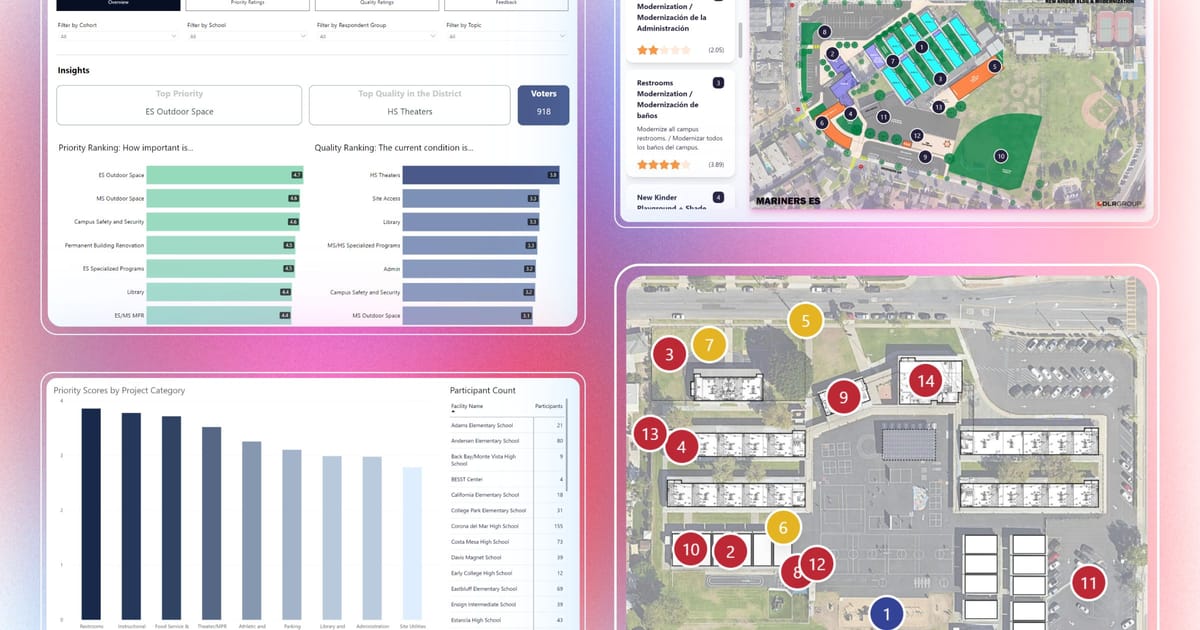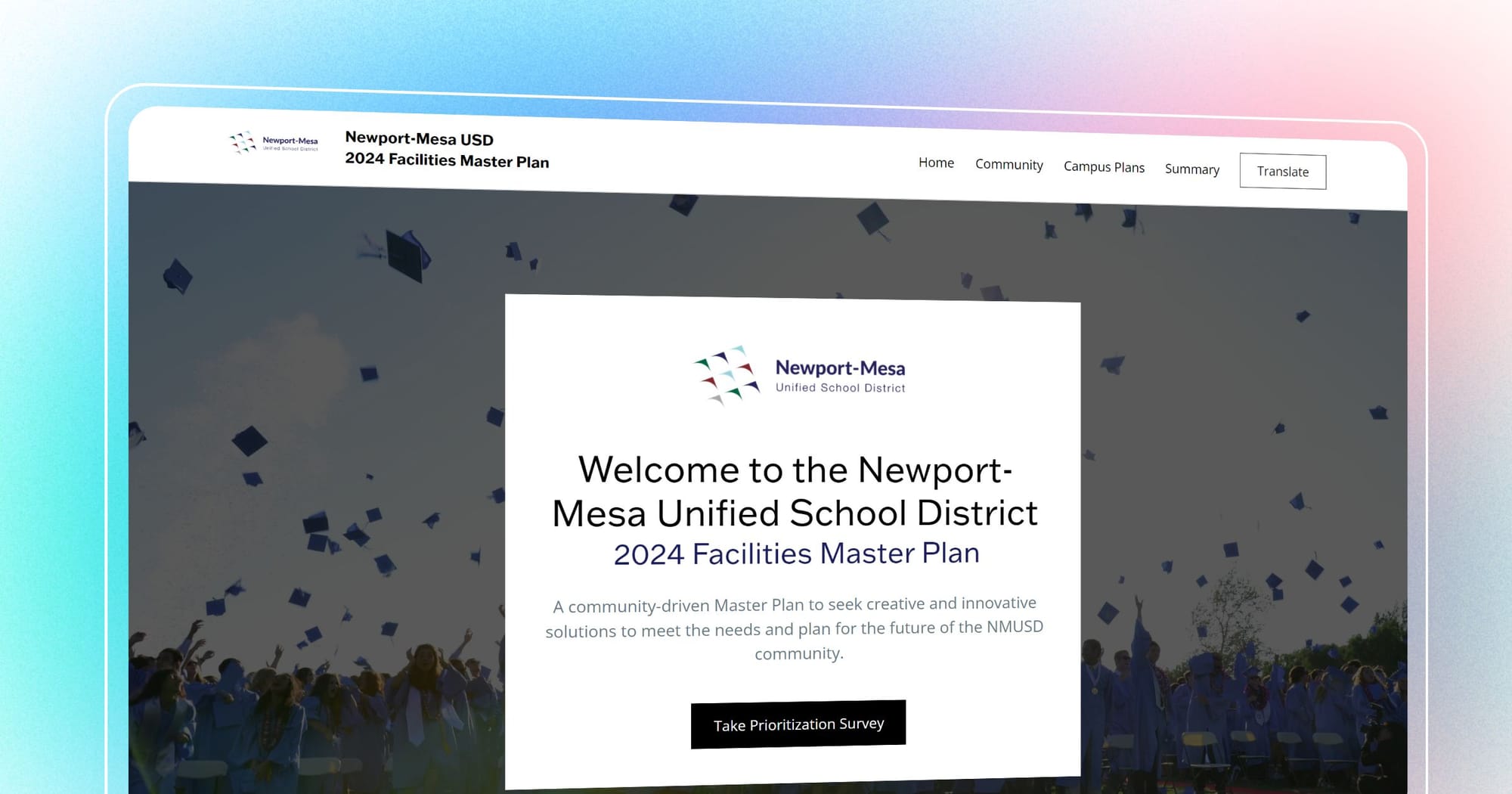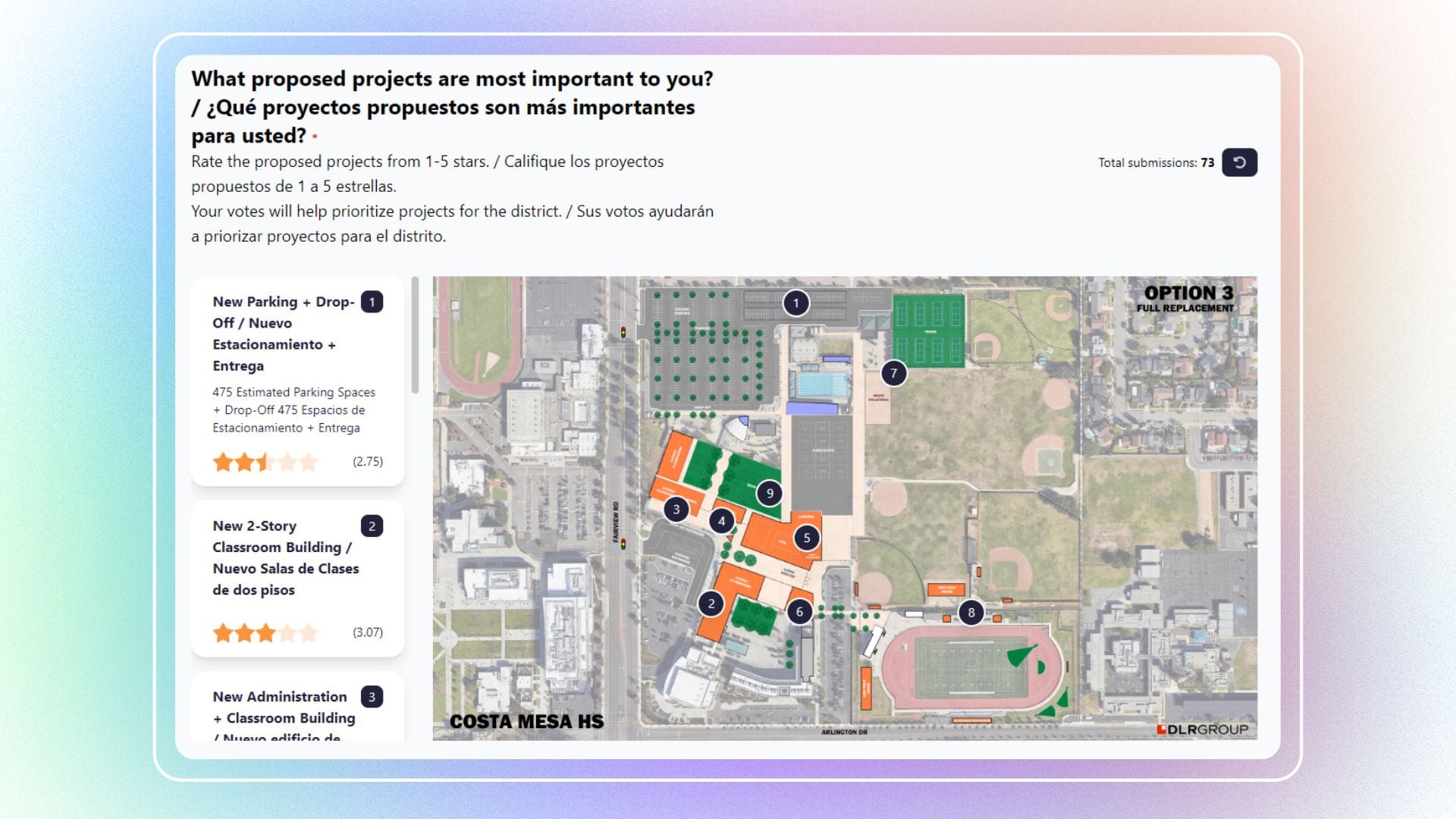How to Run Efficient and Equitable Community Engagement for K-12 Facilities Master Plans
How might we use technology to improve the quality, efficiency, and equity of community engagement?

Written by Josh Sanabria, CEO of GoArchitect.
It's no surprise that community engagement can be challenging. Whether it's issues with logistics, process, or accessibility; the boots-on-the-ground realities seldom have concrete answers.
The GoArchitect team tackled this challenge by asking ourselves, "How might we use technology to improve the quality, efficiency, and equity of community engagement?"
Simply, community engagement should be...
- High-quality
- Efficient
- Equitable
The Newport-Mesa Unified School District 2024 Facilities Master Plan served as a perfect testing ground.
In early 2024 we were presented with the opportunity to work with DLR Group on the facilities master plan for Newport-Mesa Unified School District (NMUSD). This is a large and diverse district where community buy-in was essential.
Community buy-in challenges every team member to think about the needs & input of diverse participants. Whether that comes from parents, staff, or the general public, it plays a critical role in building support for the master plan and a future bond measure.

Logistical Challenges
NMUSD is a diverse community with multiple languages. Relying solely on traditional outreach methods requires a lot of time, resources, and leaves information gaps.
We needed an outreach method that could quickly engage thousands of community members, in their language. The insights gathered should be synthesized cohesively. We don't want Spanish insights to be separate from English; the outcomes need to be merged. Speaking from experience, this is a huge challenge with in-person methods.
Expecting your team members to organically all be bilingual, capture quality information from all participants, and then input that in a unified manner is nearly impossible. They need the right tools.
Subjective vs Quantifiable Date
Adding to this challenge was that we needed both subjective and quantifiable data to fully capture the breadth of insights available from the community.
If we relied on solely interviews the information would only be subjective. While this is valuable for context and specific needs, it doesn't capture the full picture.
Subjective-only data can often lead to the loudest voice getting what it wants versus what the majority of people actually value.
Meanwhile, if we relied only on quantifiable data, for example with a ranking survey, we may loose site-specific insights. We would not be able to understand the complex story or context of a site or situation.
Quantifiable-only data can lead to a dehumanizing experience that ignores personal connections.

Stage 1: Gathering subjective insights using Engage sticky notes.
The first step in outreach was hosting in-person meetings to connect with the community and gather their insights. Participants were first asked to do a traditional sticky notes activity, in person, alongside a DLR Group team member. This team member helped ensure consistent writing quality and provided a friendly face
After the meeting, we used Engage to digitize those sticky notes. This is an advantage over old methods because we retained the knowledge and made it accessible to the team and public.
Here is a sample of the sticky notes results dashboard.
You can change the school in the top filter and hover over the dots to read them.
This Engage dashboard was embedded in the final master plan website to demonstrate the community's participation in the plan. Since it is live and interactive, it serves us better than a simple photograph of a sticky note board that is difficult to read.
In-Person or Online-Only?
For NMUSD we elected for a blended approach. However, we could have done an online-only sticky notes campaign to further improve the efficiency. The Engage sticky notes question can sit alongside other question types to form a standalone survey that may be sent to the entire district at once.
This is the approach we took for Stage 2.

Stage 2: Gathering quantifiable data from the community using Engage action dots.
Once the team had developed a list of proposed projects and site plans we used Engage action dots to enable community members to rate projects from 1-5 stars. These ratings helped us to quantifiably know the community's project priorities.
Engage action dots allow you to place "dots" on top of an image. Participants can then rate the dots from 1-5 stars.
Here is the action dots results dashboard.
You can change the school in the top filter and click the dots to see the average rating.
These dots may represent many things. For example, a dot can be a new Solar Panel and another can be the Renovation of the Science Wing. Participants prioritize projects by rating each dot from 1-5 stars. Whichever project dot receives a higher average vote, gets prioritized.
We conducted the prioritization survey in English and Spanish to improve the equity and access of the entire process.
We had the District email this survey to everyone on their email list to gather a true picture of people’s priorities. Since we can apply statistical metrics to the prioritization activity, we can quantifiably prove what the community values most. We also paired the action dots with demographic questions like how the participant was connected to the school. This information became valuable in Stage 3.

Through this activity we gathered 1,400+ responses from every corner of the district. Actions dots proved to be a powerful way to collect quantifiable data that helps build the case for prioritization.
Rather than asking binary yes/no or open-ended subjective questions, allow people to vote on a gradient. This allows for nuanced information that is still actionable.
Stage 3: Displaying this data using PowerBi.
Once we have the action dot survey results, we put this data into PowerBi to unlock deeper insights. Alongside the action dots, we asked demographic questions to provide greater context for the rankings. This came in handy as we sought to discover how different demographics were voting.
Here is the results dashboard from the Newport-Mesa Unified School District 2024 Facilities Master Plan.
As you can see, we now can quantifiably prove what types of projects are more popular with certain demographic groups. For example, we can see that Restroom related projects are popular with all demographics but Site Utilities only score high with District Staff.
This is the type of hard evidence that would be nearly impossible to gather at scale with traditional methods.
We aimed to show that in-person methods can be used in concert with Engage and other technologies to improve the quality, efficiency, and equity of community outreach.
NMUSD was an excellent example of how community engagement can be enhanced through careful planning and new technology. Engage helped with each phase of the process; from subjective conversations to quantitative priority analysis. Shoutout to the DLR Group team for their willingness to try new things and push the envelope.
Community Engagement for K-12 Facilities Master Planning is an important part of your work. Your tools should be built for what you do.
Engage is free to use with pro plans for advanced features.
You will save hours gathering feedback and be empowered with powerful and actionable data that you wouldn't have gathered otherwise. The best part is that the GoArchitect team made this tool for professionals like you.
If you don't need this hands-on guidance or you want to take a look around first, sign up for Engage for free and check it out.
Want an introduction to Engage?
Setup a 30-min free call with GoArchitect founder, Josh Sanabria. I'm available to walk you through the strategic ways you can use Engage in your work.



